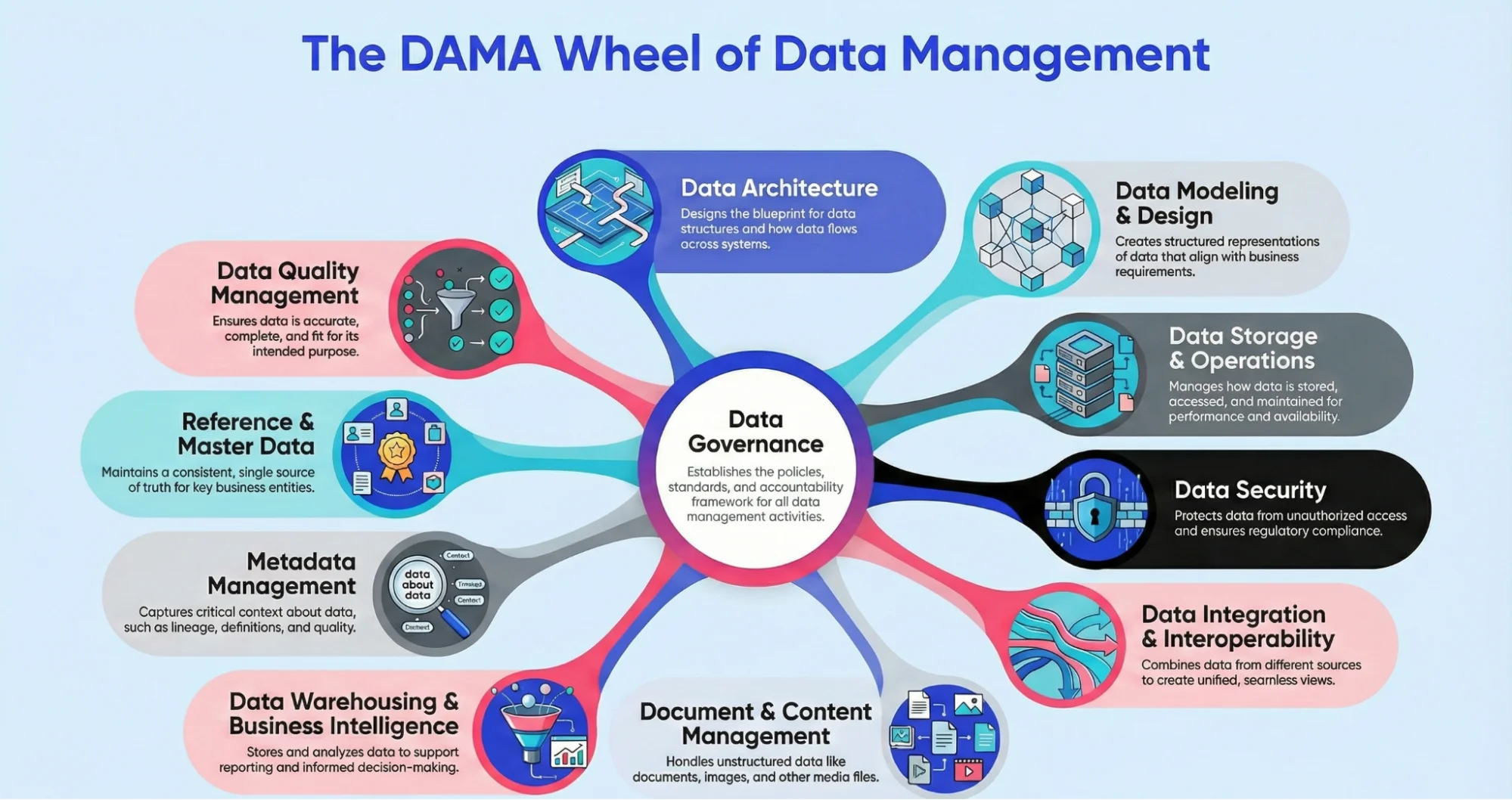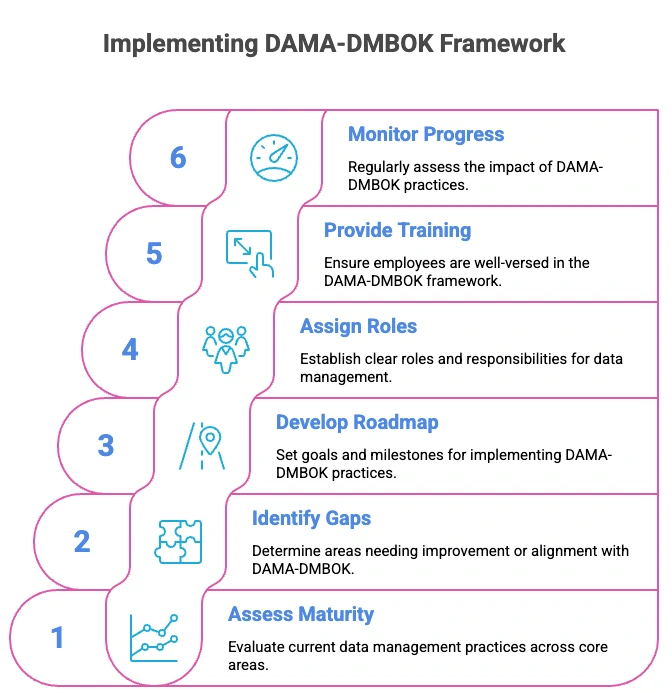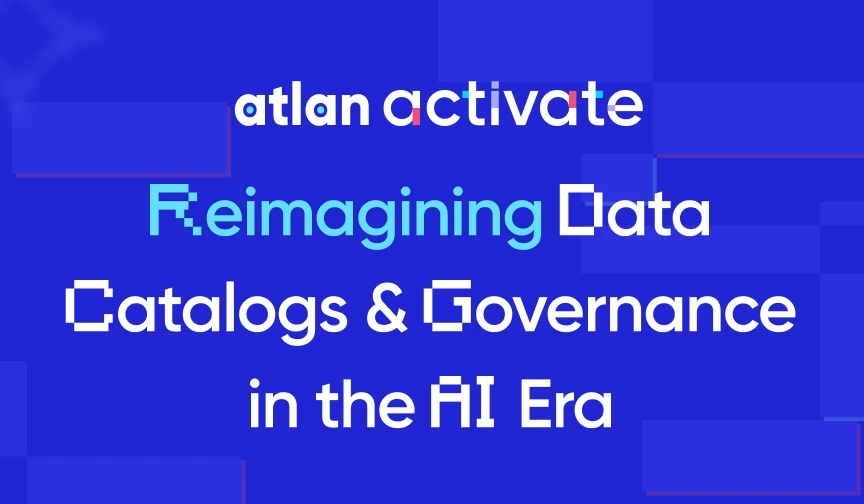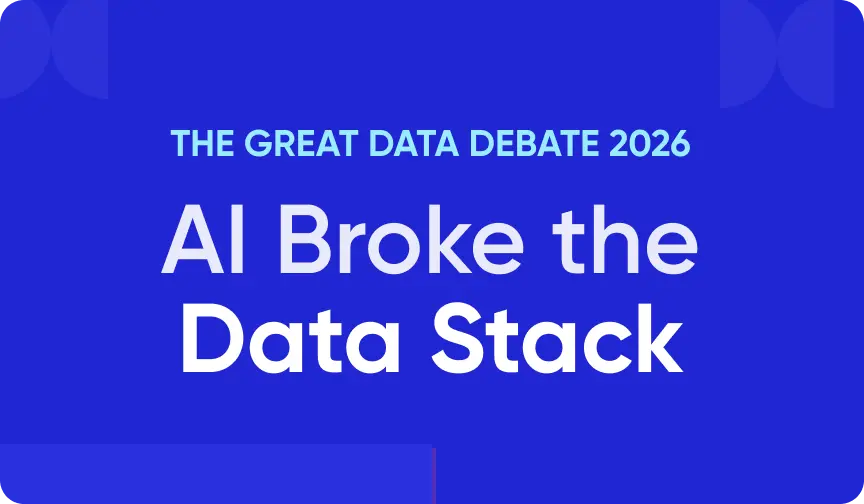DAMA-DMBOK Framework: All You Need To Know in 2026
11 core knowledge areas of DAMA DMBOK
Permalink to “11 core knowledge areas of DAMA DMBOK”Summarize and analyze this article with 👉 🔮 Google AI Mode or 💬 ChatGPT or 🔍 Perplexity or 🤖 Claude or 🐦 Grok (X) .
DAMA DMBOK organizes data management into 11 interconnected knowledge areas. Each area represents a critical discipline for managing data as a strategic asset. Together, these areas form the DAMA Wheel, with data governance at the center connecting all other domains.
1. Data governance
Permalink to “1. Data governance”Establishes policies, standards, and accountability frameworks to ensure data is managed consistently across the organization. Modern platforms like Atlan’s Active Governance automate policy enforcement rather than relying on manual documentation.
2. Data architecture
Permalink to “2. Data architecture”Designs and maintains data structures that support business strategy and enable integration across systems. Architecture decisions determine how data flows between applications, databases, and analytics platforms.
3. Data modeling and design
Permalink to “3. Data modeling and design”Creates structured representations of data through conceptual, logical, and physical models that support business operations. Effective modeling ensures data structures align with business requirements.
4. Data storage and operations
Permalink to “4. Data storage and operations”Manages how data is stored, accessed, and maintained to ensure availability and performance. This includes database administration, backup and recovery, and performance optimization.
5. Data security
Permalink to “5. Data security”Protects data from unauthorized access and ensures compliance with regulations through encryption, access controls, and monitoring. Security practices safeguard sensitive information throughout its lifecycle.
6. Data integration and interoperability
Permalink to “6. Data integration and interoperability”Combines data from disparate sources and ensures it can be exchanged across different systems seamlessly. Integration enables unified views of business entities across applications.
7. Document and content management
Permalink to “7. Document and content management”Handles unstructured data like documents and multimedia to ensure accessibility and compliance. This knowledge area addresses the 80% of enterprise data that exists outside structured databases.
8. Data warehousing and business intelligence
Permalink to “8. Data warehousing and business intelligence”Stores and analyzes data to support informed decision-making through reporting and analytics. Organizations use warehouses to consolidate data from operational systems for analysis.
9. Metadata management
Permalink to “9. Metadata management”Captures information about data including lineage, definitions, and classifications to improve discoverability. Active metadata approaches automate metadata capture and enrichment.
10. Reference and master data management
Permalink to “10. Reference and master data management”Maintains consistent, authoritative versions of key business entities across the enterprise. Master data management ensures customers, products, and other entities have single sources of truth.
11. Data quality management
Permalink to “11. Data quality management”Ensures data is accurate, complete, timely, and consistent with business requirements through continuous monitoring. Quality management prevents issues before they impact business decisions.

11 core knowledge areas of DAMA DMBOK. Source: Atlan.
What are the benefits of the DAMA-DMBOK framework?
Permalink to “What are the benefits of the DAMA-DMBOK framework?”Organizations adopt DAMA DMBOK to establish standardized data management practices that reduce risk and increase value from data assets. The framework provides both strategic guidance and tactical implementation details. Research shows that 60% of organizations have established data governance frameworks, with DAMA DMBOK serving as a common reference point.
1. Comprehensive scope
Permalink to “1. Comprehensive scope”Covers all 11 data management disciplines in one reference, eliminating the need to piece together multiple frameworks. Organizations gain a complete view rather than fragmentary guidance. The framework addresses everything from technical infrastructure to organizational change management.
2. Standardized terminology
Permalink to “2. Standardized terminology”Establishes shared language across business, IT, and data teams. This reduces miscommunication when defining data governance roles and responsibilities and policies. Common vocabulary accelerates collaboration and reduces time spent clarifying concepts.
3. Role clarity
Permalink to “3. Role clarity”Clearly defines data-related roles including data stewards, data owners, and data architects. This supports effective RACI matrix development and accountability structures. Organizations struggling with ambiguous responsibilities benefit from DAMA’s detailed role definitions.
4. Process maturity mapping
Permalink to “4. Process maturity mapping”Offers guidance for assessing current capabilities and identifying maturity levels across domains. Organizations can benchmark their practices and prioritize improvements systematically. The maturity models help justify investments by showing progression paths.
5. Vendor-neutral best practices
Permalink to “5. Vendor-neutral best practices”Provides technology-agnostic guidelines that work across any tech stack. This flexibility makes DAMA DMBOK applicable whether you’re using cloud platforms, on-premises systems, or hybrid architectures. Organizations avoid vendor lock-in while following proven practices.
6. Strong governance foundation
Permalink to “6. Strong governance foundation”Treats data governance as the central pillar connecting all other areas. This supports federated governance programs that balance centralized oversight with distributed execution. The framework shows how governance decisions ripple across all knowledge areas.
How to implement the DAMA-DMBOK framework?
Permalink to “How to implement the DAMA-DMBOK framework?”Many organizations, especially large enterprises and government agencies, have adopted or adapted the DAMA-DMBOK framework to improve their data management. These organizations span a variety of industries, such as finance, healthcare, telecommunications, retail, and public sector.
Organizations that have successfully implemented DAMA-DMBOK typically take the following steps:
- Assess their current data management maturity
- Identify gaps and areas for improvement
- Develop a roadmap for implementation
- Assign roles and responsibilities
- Provide training and support
- Monitor and measure progress
Now, let us understand each of these steps in detail.
1. Assess their current data management maturity
Permalink to “1. Assess their current data management maturity”Evaluate existing practices across the 11 knowledge areas to identify strengths and gaps. Document current policies, processes, and tool capabilities. Organizations report that 77% rate their data quality as average or worse, highlighting the need for systematic assessment.
Quickly assess your organization’s data governance maturity
Take Assessment →2. Identify gaps and areas for improvement
Permalink to “2. Identify gaps and areas for improvement”Focus on knowledge areas that align with business objectives and present highest risk. Most organizations start with data governance, data quality, or metadata management rather than attempting all areas at once. Prioritization ensures resources target areas with maximum business impact.
3. Develop a roadmap for implementation
Permalink to “3. Develop a roadmap for implementation”This includes setting goals and milestones for implementing DAMA-DMBOK practices and prioritizing areas that have the most significant impact on the organization’s data management capabilities.
Get instant 90 day data governance roadmap to serve as a foundation
Get my data governance roadmap →4. Assign roles and responsibilities
Permalink to “4. Assign roles and responsibilities”Establish clear accountability for each knowledge area. Define data stewardship responsibilities, governance council membership, and escalation paths. Role clarity prevents gaps where no one owns critical data management functions.
5. Provide training and enablement
Permalink to “5. Provide training and enablement”Ensure teams understand DAMA DMBOK principles and have access to necessary tools. Many organizations pursue CDMP certification for key team members. Training investments accelerate adoption and reduce misinterpretation of framework concepts.
6. Monitor progress and iterate
Permalink to “6. Monitor progress and iterate”Track metrics for each knowledge area and adjust approach based on results. Regular assessment ensures continuous improvement rather than one-time compliance. Organizations should review progress quarterly and refine roadmaps based on lessons learned.
However, remember that implementing the DAMA-DMBOK framework does not necessarily mean following it to the letter. Organizations often adapt and customize the framework to fit their specific needs, culture, and industry requirements.
As a result, the extent to which organizations adopt DAMA-DMBOK can vary.

How to implement the DAMA-DMBOK Framework. Source: Atlan.
DAMA DMBOK framework structure and organization
Permalink to “DAMA DMBOK framework structure and organization”DAMA DMBOK organizes its content around the DAMA Wheel, a visual representation of how data management disciplines interconnect. Data governance sits at the center, emphasizing its foundational role. The framework’s structure reflects the reality that effective data management requires coordinated effort across all knowledge areas.
The DAMA Wheel visualization
Permalink to “The DAMA Wheel visualization”The iconic DAMA Wheel places data governance at the hub with 10 knowledge areas arranged around it. This design illustrates that governance underpins every data management activity. Each knowledge area connects to governance while also relating to adjacent areas through shared processes and dependencies.
Functional framework approach
Permalink to “Functional framework approach”DAMA DMBOK provides more than definitions. It includes activities, deliverables, roles, metrics, and maturity models for each knowledge area. This functional framework helps organizations translate principles into practice through concrete implementation guidance.
Context diagrams and relationships
Permalink to “Context diagrams and relationships”The framework documents how knowledge areas depend on and support each other. For example, data quality management relies on both metadata management and data governance. Understanding these interdependencies helps organizations sequence their implementation effectively and avoid isolated initiatives.
Best practices and guidelines
Permalink to “Best practices and guidelines”Each knowledge area includes generally accepted practices gathered from hundreds of data professionals globally. DAMA DMBOK represents consensus knowledge rather than prescriptive mandates. Organizations adapt these practices to their specific contexts, industry requirements, and organizational culture.
Evolution and updates
Permalink to “Evolution and updates”DAMA International released DMBOK2 in 2017 with contributions from 120+ data professionals. The framework continues evolving, with DMBOK 3.0 in development to address emerging technologies like AI and cloud-native architectures. This evolution ensures relevance as the data governance landscape changes with new tools, regulations, and business models.
What are the challenges of the DAMA-DMBOK framework?
Permalink to “What are the challenges of the DAMA-DMBOK framework?”While DAMA DMBOK provides comprehensive guidance, implementation comes with practical considerations that teams should anticipate. The framework’s breadth can feel overwhelming for organizations starting their data governance journey. Understanding these challenges helps teams plan realistic adoption strategies.
Complexity and comprehension curve
Permalink to “Complexity and comprehension curve”With 11 knowledge areas and 600+ pages of content, DAMA DMBOK requires significant investment to master. Teams looking to show early wins may struggle with the framework’s comprehensiveness. Organizations often need to supplement DAMA DMBOK with tactical playbooks for specific tools and platforms.
Strategic guidance vs operational execution
Permalink to “Strategic guidance vs operational execution”DAMA DMBOK excels at outlining principles and roles but provides limited tactical guidance for day-to-day operations. Teams must translate framework concepts into specific processes, tools, and workflows. This translation requires data management expertise and organizational change management capabilities.
Traditional approach in modern environments
Permalink to “Traditional approach in modern environments”The framework predates many cloud-native and AI-driven practices that dominate today’s data landscape. The enterprise data management market is projected to reach $221.6 billion by 2030, driven largely by cloud adoption and AI use cases. Organizations focused on active, automated governance may need to layer modern execution strategies onto DAMA DMBOK’s foundational principles.
Heavy reliance on stewardship
Permalink to “Heavy reliance on stewardship”Effective implementation assumes clear data ownership and active business stewardship. Many organizations lack these cultural foundations and must build them while adopting the framework. This dual transformation increases complexity and extends timelines beyond technical implementation alone.
Tool-agnostic design requires translation
Permalink to “Tool-agnostic design requires translation”While vendor neutrality ensures broad applicability, it also means organizations must determine how to operationalize DAMA DMBOK within their specific technology platforms. The framework doesn’t prescribe which tools to use or how to configure them. Teams need expertise to map DAMA concepts to platform capabilities.
Resource intensity
Permalink to “Resource intensity”Comprehensive DAMA DMBOK adoption requires dedicated personnel, budget, and executive sponsorship. Smaller organizations may struggle to resource all 11 knowledge areas simultaneously. Gartner predicts that by 2027, 60% of organizations will fail to realize AI value due to incohesive governance frameworks, underscoring the importance of proper resourcing.
How modern platforms operationalize DAMA DMBOK principles
Permalink to “How modern platforms operationalize DAMA DMBOK principles”DAMA DMBOK offers a strategic blueprint for managing data, but putting its eleven knowledge areas into practice is often slow and manual. Many teams still document policies in wikis, track lineage in spreadsheets, and manage governance workflows through email. These administrative tasks drain time from strategic decision-making. It’s no surprise that 67 percent of organizations say they lack trust in their data, largely because governance frameworks remain theoretical rather than operational.
From static documentation to living governance systems
Permalink to “From static documentation to living governance systems”Modern data catalog platforms change this dynamic by turning DMBOK guidance into automated, active workflows. Atlan’s Active Governance model replaces manual documentation and coordination with system-driven execution. The platform automatically discovers data assets, infers lineage from real usage, and enforces policies directly within the tools teams already rely on. Metadata becomes active, offering relevant governance context at the exact moment someone is making a decision.
Shifting governance from coordination to strategy
Permalink to “Shifting governance from coordination to strategy”With automation handling routine tasks, governance councils can focus on policy design instead of policy administration. Organizations adopting active governance see faster policy cycles and stronger cross-team engagement. DMBOK provides the structure. Modern data governance platforms supply the operational engine that brings that structure to life at scale.
See how Atlan operationalizes DAMA DMBOK principles through automated governance and active metadata.
Real stories from real customers: Governance frameworks in action
Permalink to “Real stories from real customers: Governance frameworks in action”“Atlan is much more than a catalog of catalogs. It’s more of a context operating system… Atlan enabled us to easily activate metadata for everything from discovery in the marketplace to AI governance to data quality to an MCP server delivering context to AI models.” — Sridher Arumugham, Chief Data and Analytics Officer, Workday
Governance is an active semantic layer not a passive documentation
Watch Workday’s story →
53 % less engineering workload and 20 % higher data-user satisfaction
“Kiwi.com has transformed its data governance by consolidating thousands of data assets into 58 discoverable data products using Atlan. ‘Atlan reduced our central engineering workload by 53 % and improved data user satisfaction by 20 %,’ Kiwi.com shared. Atlan’s intuitive interface streamlines access to essential information like ownership, contracts, and data quality issues, driving efficient governance across teams.”
Data Team
Kiwi.com
🎧 Listen to podcast: How Kiwi.com Unified Its Stack with Atlan

One trusted home for every KPI and dashboard
“Contentsquare relies on Atlan to power its data governance and support Business Intelligence efforts. Otavio Leite Bastos, Global Data Governance Lead, explained, ‘Atlan is the home for every KPI and dashboard, making data simple and trustworthy.’ With Atlan’s integration with Monte Carlo, Contentsquare has improved data quality communication across stakeholders, ensuring effective governance across their entire data estate.”

Otavio Leite Bastos, Global Data Governance Lead
Contentsquare
🎧 Listen to podcast: Contentsquare’s Data Renaissance with Atlan
Key takeaways on DAMA DMBOK framework
Permalink to “Key takeaways on DAMA DMBOK framework”The DAMA DMBOK framework offers a solid, vendor-neutral foundation for enterprise data management through its eleven knowledge areas. Its value comes from adapting the guidance to your organization’s realities, not following it rigidly. The strongest implementations begin with an honest capability assessment, focus on the knowledge areas that matter most to current business priorities, and expand in manageable phases.
While the framework’s principles remain reliable, effective execution now relies on platforms that automate governance workflows and deliver real-time context to data users. Teams that pair DAMA’s strategic structure with modern operational tooling are best positioned to treat data as the strategic asset it is.
Atlan enables organizations to put DAMA DMBOK principles into practice in today’s data environments.
Let us help you build it
Book a Personalized Demo →FAQs about the DAMA DMBOK Framework
Permalink to “FAQs about the DAMA DMBOK Framework”1. What is the DAMA DMBOK Framework?
Permalink to “1. What is the DAMA DMBOK Framework?”The DAMA DMBOK Framework, developed by DAMA International, is a comprehensive guide for managing data within an organization. It provides principles, practices, and processes for effective data governance, quality, and security, covering the entire data lifecycle.
2. How does the DAMA DMBOK Framework help in data management?
Permalink to “2. How does the DAMA DMBOK Framework help in data management?”The framework assists organizations by offering standardized practices for data governance, data quality, and metadata management. It aligns data processes with business goals, improving decision-making and ensuring compliance with regulatory standards.
3. What are the key principles of the DAMA DMBOK Framework?
Permalink to “3. What are the key principles of the DAMA DMBOK Framework?”The DAMA DMBOK Framework is built on principles such as data governance, stewardship, data quality, and metadata management. These principles ensure reliable data management practices, enabling organizations to manage data effectively across its lifecycle.
4. How can organizations implement the DAMA DMBOK Framework?
Permalink to “4. How can organizations implement the DAMA DMBOK Framework?”Organizations can implement the framework by assessing their current data management maturity, defining roles and responsibilities, and applying the framework’s best practices to specific data domains. Tools like data catalogs and governance platforms can support this implementation.
5. What are the benefits of adopting the DAMA DMBOK Framework?
Permalink to “5. What are the benefits of adopting the DAMA DMBOK Framework?”Adopting DAMA DMBOK offers benefits such as improved data quality, enhanced compliance, streamlined data processes, and better alignment of data management strategies with business objectives. It provides a structured approach to managing data as a valuable asset.
6. How does DAMA DMBOK Framework ensure data governance?
Permalink to “6. How does DAMA DMBOK Framework ensure data governance?”The framework defines clear roles, responsibilities, and processes for data governance. It emphasizes accountability and standardization, ensuring that data is managed securely and consistently across the organization.
7. What is the difference between DAMA DMBOK and DAMA DMBOK2?
Permalink to “7. What is the difference between DAMA DMBOK and DAMA DMBOK2?”DMBOK2 is the second edition released in 2017, expanding from 8 to 11 knowledge areas. It added sections on data ethics, big data, and data management maturity assessment. DMBOK2 features contributions from 120+ data professionals and reflects modern data challenges. Organizations should reference DMBOK2 as it represents current best practices, though DMBOK 3.0 is in development to address AI and cloud-native architectures.
8. How long does it take to implement DAMA DMBOK?
Permalink to “8. How long does it take to implement DAMA DMBOK?”Implementation timelines vary from 6 months to several years depending on organizational size, maturity, and scope. Most organizations adopt the framework incrementally, starting with 2-3 priority knowledge areas. Full adoption across all 11 areas typically requires 18-36 months with dedicated resources. Organizations showing early wins often accelerate broader adoption through demonstrated value.
9. Is DAMA DMBOK certification required to use the framework?
Permalink to “9. Is DAMA DMBOK certification required to use the framework?”No certification is required to use DAMA DMBOK. The framework is publicly available for any organization to adopt. However, the Certified Data Management Professional (CDMP) credential validates individual expertise in DAMA DMBOK principles. Many organizations pursue CDMP certification for key team members to ensure proper framework understanding and accelerate implementation.
10. Can DAMA DMBOK work with other frameworks like COBIT or ISO?
Permalink to “10. Can DAMA DMBOK work with other frameworks like COBIT or ISO?”Yes, DAMA DMBOK complements other frameworks rather than replacing them. Organizations often use COBIT for IT governance while applying DAMA DMBOK specifically for data management. ISO standards can coexist with DAMA DMBOK by providing regulatory compliance guidance. The key is mapping how frameworks overlap and assigning clear ownership for each area.
11. What is the DAMA Wheel and why does it matter?
Permalink to “11. What is the DAMA Wheel and why does it matter?”The DAMA Wheel is a visual representation showing data governance at the center with 10 knowledge areas arranged around it. This design emphasizes that governance connects to every data management discipline. The wheel illustrates interdependencies between knowledge areas, helping organizations understand implementation sequences and coordination needs across teams.
12. How does DAMA DMBOK address AI and machine learning governance?
Permalink to “12. How does DAMA DMBOK address AI and machine learning governance?”DMBOK2 included sections on big data and analytics but predates many modern AI governance challenges. DAMA International is developing DMBOK 3.0 to explicitly address AI governance, including model management, bias detection, and responsible AI practices. Organizations implementing AI should supplement current DAMA DMBOK guidance with AI-specific frameworks and platforms designed for ML governance.
Share this article
Atlan is the next-generation platform for data and AI governance. It is a control plane that stitches together a business's disparate data infrastructure, cataloging and enriching data with business context and security.
DAMA-DMBOK: Related reads
Permalink to “DAMA-DMBOK: Related reads”- What is data governance & why does it matter?
- 11 Best Data Governance Software in 2026 | A Complete Roundup of Key Strengths & Limitations
- Data Governance Framework: Examples, Standards & Templates
- 7 Top AI Governance Tools Compared | A Complete Roundup for 2026
- 7 Best Practices for Data Governance to Follow in 2026
- Benefits of Data Governance : 4 Ways It Helps Build Great Data Teams
- Data Governance Roles and Responsibilities: A Quick Round-Up
- Data Governance Policy: Examples, Templates & How to Write One
- Key Objectives of Data Governance: How Should You Think About Them?
- 5 Popular Data Governance Certifications & Trainings in 2026
- 8 Best Data Governance Books Every Data Practitioner Should Read in 2026
- Automated Data Governance: How Does It Help You Manage Access, Security & More at Scale?
- Top data catalog tools — Compare the top data catalog tools of 2026
- Snowflake Data Catalog: Importance, Benefits, Native Capabilities & Evaluation Guide
- AI Data Catalog: Exploring the Possibilities That Artificial Intelligence Brings to Your Metadata Applications & Data Interactions
- Data Lineage Tracking | Why It Matters, How It Works & Best Practices for 2026
- Data Lineage Solutions| Capabilities and 2026 Guidance
- Data Catalog Market: Current State and Top Trends in 2026
- Build vs. Buy Data Catalog: What Should Factor Into Your Decision Making?
- How to Set Up a Data Catalog for Snowflake? (2026 Guide)
- Data Catalog Pricing: Understanding What You’re Paying For
- Data Catalog Comparison: 6 Fundamental Factors to Consider
- Best Data Governance Tools in 2026 — A Complete Roundup of Key Capabilities
- 5 Best Data Governance Platforms in 2026 | A Complete Evaluation Guide to Help You Choose
- Data Catalog Demo 101: What to Expect, Questions to Ask, and More
- Data Mesh Catalog: Manage Federated Domains, Curate Data Products, and Unlock Your Data Mesh
- Best Data Catalog: How to Find a Tool That Grows With Your Business
- How to Build a Data Catalog: An 8-Step Guide to Get You Started
- The Forrester Wave™: Enterprise Data Catalogs, Q3 2024 | Available Now
- How to Pick the Best Enterprise Data Catalog? Experts Recommend These 11 Key Criteria for Your Evaluation Checklist























